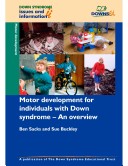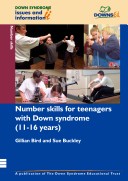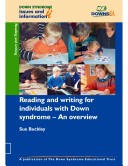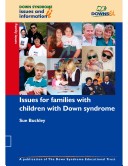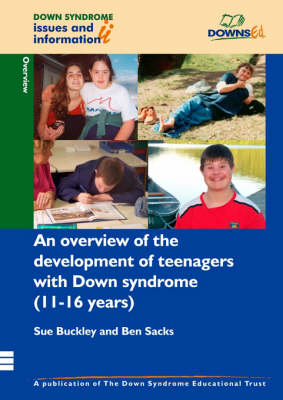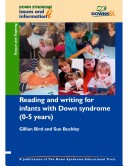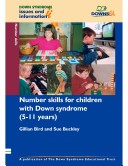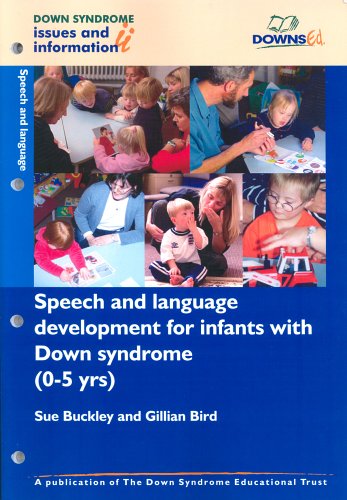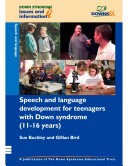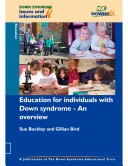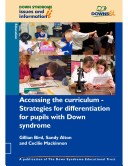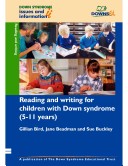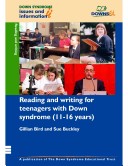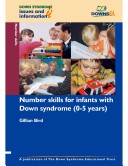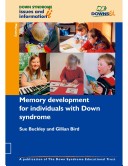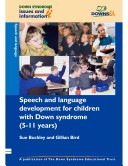Down Syndrome Issues & Information
20 total works
Motor Development for Individuals with Down Syndrome
by Ben Sacks and Sue Buckley
Number Skills for Teenagers with Down Syndrome (11-16 Years)
by Gillian Bird and Sue Buckley
The information and activities cover a range of skills, from basic to advanced, in order to meet the needs of all teenagers, whatever their current level of achievements, and they should be equally relevant in mainstream or special education classrooms. This module links with the overview module which presents and discusses the research on number for children with Down syndrome and the implications for teaching and learning.
Number Skills for Individuals with Down Syndrome
by Gillian Bird and Sue Buckley
This overview module reviews the development of number and maths skills in typically developing children, research on number and mathematics for children with Down syndrome, the implications for teaching and learning, inclusion in the mathematics curriculum, typical levels of achievement across the age range and the necessity for language teaching. This overview module links with the practical number modules for children aged 3-5 years, 5-11 (primary) and 11-16 years (secondary pupils). These modules contain discussion of the range of achievements, teaching methods and practical activities for each age group.
There are considerable individual differences in rates of literacy progress among children with Down syndrome, but if they have access to good teaching, their reading abilities are, on average, about two years behind their age in primary school, while language and number abilities are often more delayed, therefore reading ability is a strength for many of the children. Recent studies from Australia and the UK indicate that some 60% to 70% of individuals with Down syndrome can achieve functional levels of literacy by adult life. Children introduced to literacy as a language teaching activity in preschool years reach the highest levels of achievement, but individuals may make significant progress at any age into early adulthood, and many late starters do achieve functional levels of literacy. Reading should be taught and pupils involved in the daily use of literacy throughout teenage and adult years, particularly for those individuals who may not have made progress earlier.
Families are encouraged to evaluate their own situation using this information and to identify any additional resources that they could use. Practitioners are encouraged to use the information to improve their practice and to focus on family centred ways of working, recognising that the family unit is the child's main resource throughout his or her life-time.
Lesing Og Skriving Hos Smabarn Med Down Syndrom (0-5 Ar)
by Gillian Bird and Sue Buckley
An Overview of the Development of Teenagers with Down Syndrome (11-16 Years)
by Sue Buckley and Ben Sacks
The books have been written by many of the world's leading experts and are based on years of research and hands-on experience.
Reading and Writing for Infants with Down Syndrome (0-5 Years)
by Sue Buckley and Gillian Bird
This module is linked with Reading and writing development for individuals with Down syndrome - An overview,[DSii-07-01] which should be read first, to provider the reader with evidence for the benefits of early reading and the rationale behind the programme.
Number Skills for Children with Down Syndrome (5-11 Years)
by Gillian Bird and Sue Buckley
"Down Syndrome Issues and Information" is a major series of practical and informative books covering the full range of developmental, health and social issues relating to individuals with Down syndrome.
Speech and Language Development for Infants with Down Syndrome (0-5 Years)
by Gillian Bird and Sue Buckley
Building a spoken vocabulary to 400 words by 5 years of age is seen as a priority, in order to develop grammar and phonology, and a recommended vocabulary programme with record sheets is included. The ways in which reading activities should be used to support all aspects of speech and language learning during preschool years are mentioned but the detailed advice on teaching early reading is in the reading module. This module follows on from Speech and language development for individuals with Down syndrome - An overview [DSii-03-01] which should be read first, to provide the reader with an adequate understanding of speech and language development to be successful in using this programme.
Social Development for Individuals with Down Syndrome
by Sue Buckley, Gillian Bird, and Ben Sacks
Information on the types of behaviour which may cause concern is included and attention is drawn to the high incidence of sleep difficulties as they influence day time behaviour. Strategies for encouraging age-appropriate behaviour are discussed and ways of preventing and changing difficult behaviours are outlined.
Speech and Language Development for Teenagers with Down Syndrome (11-16 Years)
by Gillian Bird and Sue Buckley
The activities are equally relevant to special education and mainstream education settings. This module follows on from Speech and language development for individuals with Down syndrome - An overview [DSii-03-01] which should be read first. This will provide the reader with a basic understanding of speech and language development and approaches to therapy.
Education for Individuals with Down Syndrome
by Sue Buckley and Gillian Bird
Accessing the Curriculum
by Sue Buckley, Gillian Bird, and Cecilie MacKinnon
An Overview of the Development of Children with Down Syndrome (5-11 Years)
by Ben Sacks
The books have been written by many of the world's leading experts and are based on years of research and hands-on experience.
Reading and Writing for Children with Down Syndrome (5-11 Years)
by Gillian Bird, Jane Beadman, and Sue Buckley
Reading and Writing for Teenagers with Down Syndrome (11-16 Years)
by Gillian Bird and Sue Buckley
This module should be read in conjunction with Reading and writing for individuals with Down syndrome: An overview,[DSii-07-01] as the overview provides important background information on how individuals learn to read, the adaptations that will help pupils with Down syndrome, and the benefits of being involved in reading instruction.
Number Skills Development for Infants with Down Syndrome (0-5 Years)
by Gillian Bird and Sue Buckley
Some children will learn in very small steps, with each aspect broken down for them, taught and practised, other children will develop skills more quickly, after they have been helped to learn about numbers using visual aids, through good teaching and from multi-sensory learning experiences. This module provides examples for everyday social interaction, language teaching and games that can help to develop early number and maths skills, beginning with nursery rhymes, songs, play and words, introducing activities from one year of age up until the child goes to school. Vocabulary lists for maths concepts that will be useful for parents of children to early school age are included. This module should be read in conjunction with Number skills for individuals with Down syndrome - An overview.[DSii-09-01]
Memory Development for Individuals with Down Syndrome
by Sue Buckley and Gillian Bird
There is evidence that there is a basic impairment in phonological loop functioning in children with Down syndrome. This is probably a major reason for their speech and language delays and difficulties and it also affects their ability to process spoken language and carry out cognitive tasks. Memory training studies indicate that it is possible to improve the short-term memory skills of children with Down syndrome. However, the biggest gains in short-term memory skills reported are linked to reading instruction and to being in a mainstream school. Reading activities may provide auditory training experiences which actually improve phonological coding (the accurate representation of the sound patterns of words) in the phonological loop. Memory training activities and support for weak auditory memory skills are discussed. However, a range of activities to improve speech sound and word discrimination are included, as they may improve basic phonological loop function and therefore result in the greatest gains for spoken language abilities and working memory.
